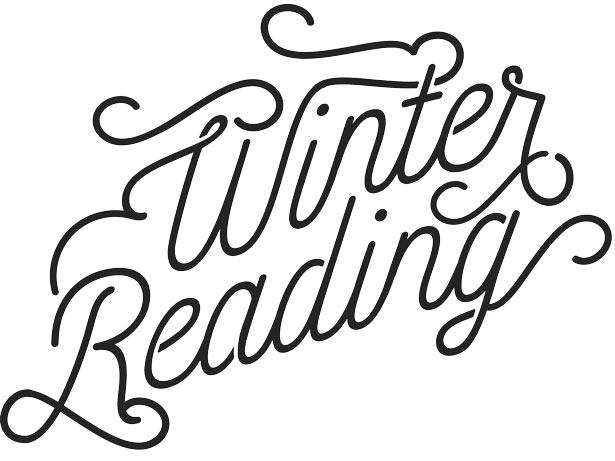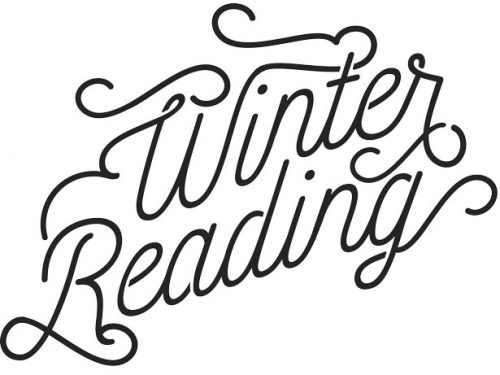
![]() = Oregon author or Oregon-centric book
= Oregon author or Oregon-centric book
fiction
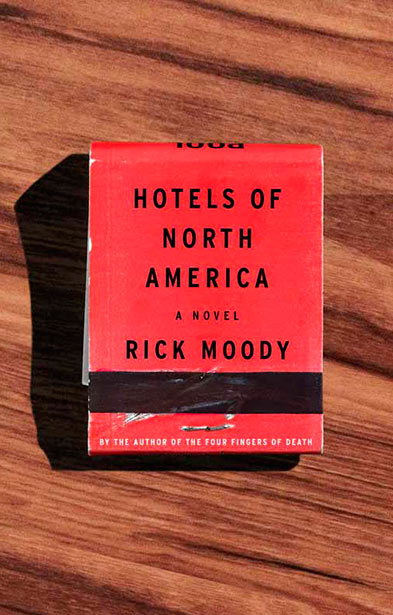
Hotels of North America by Rick Moody. Little, Brown & Company, $25.
The narrator of Rick Moody’s latest novel, Reginald E. Morse, is little more than the shadow of a shell of a man. As a popular online critic of hotels, R.E. Morse (get it?) lives a largely itinerant existence, traveling from overnight hookups in Chicago to fleabag vigils in meth-addled Eugene. Back and forth across this broken nation he goes, an embedded reporter reporting back from his various accommodations in a sesquipedalian prose that tells us less about specific lodgings than the besieged state of Morse’s own head. The result is a literary jigsaw, by turns haunting and infuriating. In a conceit familiar to anyone who’s read Hawthorne, Moody frames the novel as a sort of “found manuscript,” and it is Morse’s sudden and unexplained disappearance that drives the queasy mystery at the heart of these fictionally collected fictional writings. Did Morse, in the end, find salvation? Did he kill himself? Unfortunately, it can be difficult to care either way. Despite some truly moving passages about the reviewer’s busted marriage and alienated daughter, Morse remains an opaque and rather unlikable character — an intelligent man whose staggering confessions of personal failure are so tangled and verbose that they knit a digital scrim of mere language, creating clever distances instead of emotional proximity. Or maybe that’s the point: Our monolithic digital culture, which gouges a wider and wider gap between yammering avatars of our actual selves, is killing any real connection among real people. Moody himself, in an afterword, suggests how we might view Morse’s writings, as missives that “tell us more about the future than they tell us about hotels.” As prolix as he was, Melville never tipped his hand like this (“Alas, ye pilgrims, the white whale is blasted nature and Ahab is the Enlightenment!”), and whether you find this sort of slyness irritating or tasty might suggest your personal response to Moody’s brand of fiction-making. — Rick Levin
A Cure For Suicide by Jesse Ball. Pantheon Books, $24.
Any year a Jesse Ball novel is published is a good year. This was a good year. A Cure for Suicide — not dystopian, but creatively alternate in its description of a dramatic and irreversible kind of medical treatment at a facility for people who have suffered some final loss of hope — is easy to throw aside if you need to place it within a particular genre.
This book has a touch of the odd, systemic place where you are not given front or back, but that lingers in a liminal space that is both familiar and utterly estranged from reality as we know it — eerie, prison-like and existing under its own logic. The space of this novel is a gauzy room of mirrors that induces the feeling of being drugged and unclear, as most of the characters in the book are.
Ball seduces with his obvious love of language and a love story is visible beneath the wispy framework of a plot. If you can stomach a novel without a transparent narrative arc and enjoy imaginative writing, this one will serve you well. — Paul Quillen
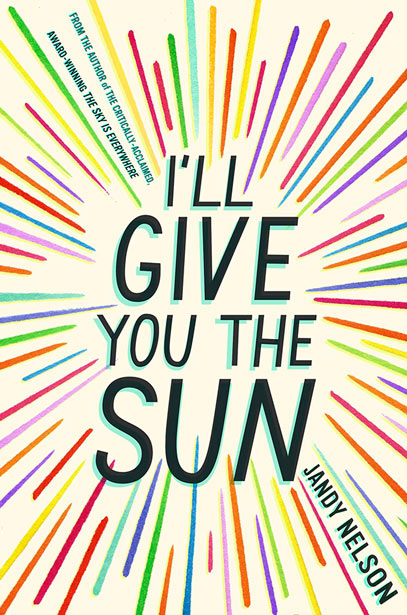
I’ll Give You the Sun by Jandy Nelson. Speak, $10.99.
Jandy Nelson’s I’ll Give You the Sun is the winner of the 2015 Printz Award for Excellence in Young Adult Literature and lauded by publications and public libraries around the country. It’s the story of Jude and her twin brother Noah, but really it’s two stories. Noah draws unceasingly, and he’s falling in love with the boy next door. Jude’s a rebel, a daredevil and an aspiring sculptor. They used to be inseparable. Now, though they live across the hall from each other, tragedy has ripped them apart. The story they each tell is of trying to put themselves, each other and their family back together.
The chapters alternate between Noah’s point of view and Jude’s — but Noah’s point of view is two years in the past. Sometimes what Noah doesn’t yet know makes the reader gasp and want to shield him from what is coming. But in the present — or, from Noah’s point of view, the future — Jude herself has only half the story to tell. This separation in time, irrevocable in the space of the narrative, serves to piercingly mirror the twins’ emotional distance. The language in I’ll Give You the Sun teems with simple, vivid, rhythmic authenticity. Nelson captures with startlingly exaggerated prose the feeling of being young and feeling like you’re alive for the first time, like you’re maybe the first person who has ever really been alive.
This book is about family, forgiveness, love and the healing power of making art. Something novelist Nick Hornby said comes to mind: “I see now that dismissing YA books because you’re not a young adult is a little bit like refusing to watch thrillers on the grounds that you’re not a policeman or a dangerous criminal, and as a consequence, I’ve discovered a previously ignored room at the back of the bookstore that’s filled with masterpieces I’ve never heard of.” I’ll Give You the Sun is a beautiful book I would recommend for young adults and what I think of as “real” adults alike. — Meli Ewing
![]() Vintage by David Baker. Touchstone, $16.
Vintage by David Baker. Touchstone, $16.
Taken as a whimsical romp through Europe with tantalizing descriptions of food and drink, this book is enjoyable. However, as someone who appreciates respectable protagonists with redeeming qualities, I also found it immensely frustrating.
Vintage tells the story of Bruno Tannenbaum, a washed-up food writer in Chicago who’s circling the bottom of the drain, mostly due to his refusal to live in the modern world and his unabashedly flagrant passion for living the high life. Separated from his wife and sleeping on his mom’s couch, Bruno dreams of redeeming himself by producing a brilliant novel, but it goes nowhere until he discovers a mysterious, WW II-era vintage wine in a storage locker and embarks on a cross-continental journey to track down its origin story.
His stops in France, Germany and Russia are delightful, capturing subcultures and culinary customs with intoxicating detail. The aromas of the meals, from honey-ginger glazed salmon to freshly baked French bread, waft from the pages.
My main complaint is Bruno himself. His complete lack of self-control strikes me as woefully irresponsible and juvenile, and though most of his success comes from his ability to charm folks of all backgrounds and interests, I find these scenes unconvincing. I couldn’t stop myself from rolling my eyes when he yet again uses his severely limited funds to buy the most decadent produce he can find. It’s a fun story, but the maddening missteps of the main character prevented me from enjoying it completely. — Amy Schneider

Wind/Pinball: Two Novels By Haruki Murakami. Knopf, $25.95.
Hear the Wind Sing and Pinball, 1973 were Murakami’s first two novels, which I am happy to see reprinted in this handsome volume, since I missed the opportunity to purchase them used when they were reasonably priced, prior to his becoming the popular author he is today. There is also a fantastic introduction in which Murakami gives a brief, intimate summary of the start of his writing career.
These novels are the first in a series often referred to as The Rat Trilogy, which contains a fourth volume, Dance Dance Dance, usually omitted for reasons I am unsure of. In terms of content, Wind/Pinball lack much of the surreal character of the later novels but are an interesting precursor to the rest of Murakami’s oeuvre, and contain seeds of his later work.
I read these short novels with an interest in seeing both if I would like them and if they would rekindle a desire to reread his later novels, which I had once been enamored with. I wasn’t disappointed with these two brief “coming-of-age” tales, as most reviewers classify them, and have been working my way back through his other work as a result of that enjoyment. — Paul Quillen
short stories
The Assassination of Margaret Thatcher by Hilary Mantel. Picador, $16.
Hilary Mantel is the sort of writer who makes other writers want to quit writing. Her prose is magnificent, resplendent, inimitable; it flutters off the page like a kind of breezy but acute argot, effortlessly meshing conversational shorthand with British pomp and registering the subtlest tones of class and gender and domestic conflict. But she is, first and foremost, a fantastic storyteller, given to details and observations that cause her fiction to burst alive in the reader’s mind.
Her short story collection, The Assassination of Margaret Thatcher, is packed with moments that catch the breath: a pair of unlikely attic windows are described as “surprised,” a man in contemplation is seen “as if he were the warden of his own identity,” cherry trees “toss extravagant flounces of blossom” to the pavement. Such intimacies extend to every nook and cranny of the writing, bringing to life a breathing, throbbing, three-dimensional world in which everyday people doing everyday things become, somehow, grander than the picayune facts of their existence. As with the “catharses” of James Joyce, each story hinges on some peculiar twist or surprise of fate, honestly earned, and yet each sentence Mantel lays on the page is, in some sense, cathartic: perfectly rendered, emotionally resonant and exquisitely lapidary, as permanent and incontrovertible as a final verdict. — Rick Levin
A Manual for Cleaning Women: Selected Stories by Lucia Berlin. Farrar, Straus and Giroux, $26.
Restless yet assured, frenetic yet searching, the short stories of Lucia Berlin tap out like spooling subtitles deciphering the mad gibberish of unreconstructed reality. Berlin, who died in 2004 at the age of 68, lived a crazy life — itinerant childhood, boho youth, odd jobs, marriages, divorces, addiction, recovery, restless relocations across the U.S. and into Mexico — and her stories grab bits and pieces of this wooly existence, patching them together with an artfulness and honesty that feels truer than true. Innocence and wisdom, sin and salvation find a precarious balance in Berlin’s fiction.
Her writing is confidential and intimate and revelatory, a family secret whispered on a vapor of sloe gin. Like Chekov, she drops you smack-dab into the action, after which you are carried along on a breathless narrative that thrums like a heartbeat, sometimes irregular, sometimes serene. One story opens: “Wait. Let me explain…” And the explanations are like a flare, lighting up the darkness.
Until now, Berlin has been largely undiscovered by the wider world, remaining a cherished secret among swooning fans who pass her tattered books back and forth with reverence. The publication of these selected stories in such a gorgeous collection (with an intro by Lydia Davis), then, is an act of belated grace, setting the world right and placing Berlin, finally, among the greatest short-story writers of the 20th century. — Rick Levin
Slade House by David Mitchell. Penguin Random House, $26.
Slade House could be labeled a dark fantasy or horror novel and is broken into segments that would be enjoyable as individual vignettes, but are nicely combined as episodic cycles.
Within each segment, someone’s soul is stolen and the rules and circumstances surrounding the history and character of those doing the thieving are teased out, bit by bit. As the story progresses, ensnaring victims in their sinister net grows increasingly difficult. Though dark, the story is not gory.
It is ultimately a ghost story borrowing lightly from the annals of Western esoteric, mystical lore, which feels a little bit like Guillermo del Toro lite and has a playful edge. Scenery warps and shifts around its characters, but no plot elements are left to guesswork in terms of the mechanics of the paranormal realm and how and why they parallel a London neighborhood.
This was my first David Mitchell novel, but sources suggest that characters and content from earlier works make their appearance. It is a quick, well-crafted read, exhibiting an ease and confidence of a writer who has maintained a high level of success and doesn’t have to pander to his readers or tiptoe across his sentences. — Paul Quillen
The Bell Tolls for No One by Charles Bukowski. City Lights Books, $14.95.
The rough-and-tumble stories collected in this new volume, spanning the years 1948 to 1985 and originally published in small zines like Open City and L.A. Free Press, reveal the late, great writer Charles Bukowski (1920-1994) at this best and, as we’ve come to expect, his worst. Alcoholic, cantankerous and given to hilarious bursts of misanthropic disgust and dismay, Bukowski could turn the most mundane detail of his hardscrabble existence — poverty, booze, gambling, fighting, fucking — into an elevated ode to skid-row reality. On the surface, Bukowski, the ultimate loner, is at war with the world; but beneath his lean, bone-scraping prose pulses a deeper compassion for the world’s suffering ways, which allows the man to speak unpleasant and untimely truths, mostly about himself. “Precious holy things finally lack accurate glory,” he writes at the conclusion of a story about a clownish ruffian he drank with. Bukowski’s stories strive to grant an honest, accurate glory to the beautiful losers in his life, and it’s this struggle that makes his writing so compelling. It ain’t usually pretty, but it’s always strong and honest. It’s hard to believe that, 20 years after Bukowski’s death, new or long out of print stories continues to emerge — and not only new, but among some of the finest he ever set to paper. — Rick Levin
nonfiction
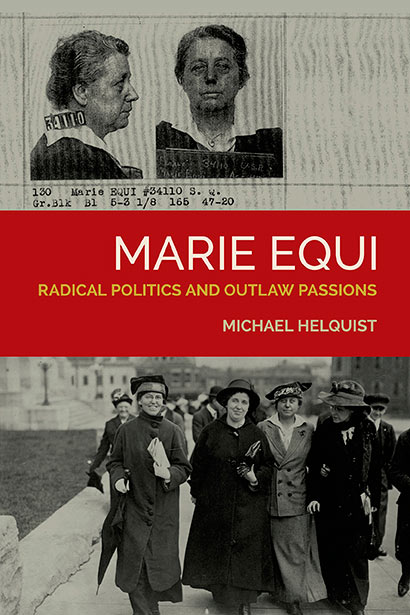
![]() Marie Equi: Radical Politics and Outlaw Passions by Michael Helquist. OSU Press, $24.95.
Marie Equi: Radical Politics and Outlaw Passions by Michael Helquist. OSU Press, $24.95.
I have one takeaway from this biography: Marie Equi was a badass. A suffragette, union supporter, lesbian and doctor in the late 1800s and early 1900s, Equi ran rampant throughout Portland and other regions of the West Coast, supporting causes she knew in her heart to be right, even if it meant going to jail. Author and historian Michael Helquist skillfully outlines the fierce tenacity and incredible courage Equi exemplifies throughout her life, giving equal attention to her passion for medicine, her lesbian lifestyle and her unwavering commitment to activism.
Equi and her story provide a tangible framework to the period of time in which she lived, and the book includes fascinating glimpses of Portland life and culture in the early 1900s.
Equi existed solidly outside the norm, performing abortions, romancing other women and fighting for the working class by advocating for fair working conditions and better hours. Shockingly ahead of her time, Equi was both respected and reviled by her peers. While it’s difficult to read about the injustices she suffered for her activism, such as being jailed for nearly a year and condemned as a radical, Helquist’s tribute to this historical figure is nothing short of brilliant, and I hope it brings Equi more well-deserved fame. — Amy Schneider
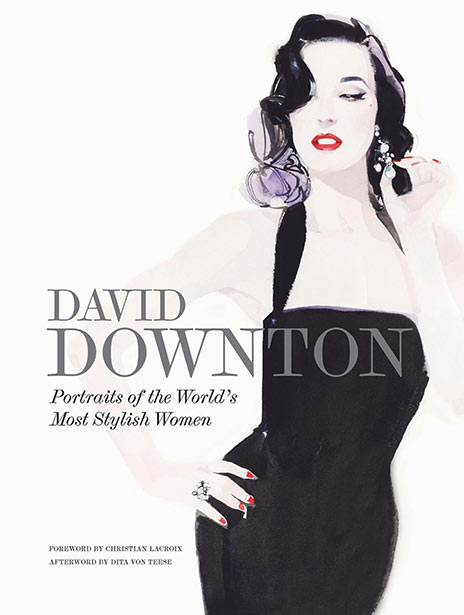
David Downton: Portraits of the World’s Most Stylish Women by David Downton. Laurence King, $65.
All artists hope to eke out the sublime in their work, and famed Vogue illustrator David Downton has managed to do so in every flick of his brush and painted watery line featured in David Downton: Portraits of the World’s Most Stylish Women. If you love art, fashion or pop culture, you’ll drool over every lux full-color watercolor illustration in this tome. Downton has proven he is the living master of what he does, and the likes of Dita Von Teese, Iman and Catherine Deneuve can’t line up fast enough to be forever captured by his Midas touch. — Alex V. Cipolle
Snowden by Ted Rall. Seven Stories Press, $17.
Hopefully, President Obama, whose campaign promises included an end to illegal wire-tapping, will be remembered as a smarmy fraud. Sound harsh? Read Ted Rall’s Snowden, a comic book biography about the NSA systems administrator who leaked to the press evidence showing that “the U.S. government spent hundreds of billions of our tax dollars to build the most sophisticated, wide-ranging, and intrusive surveillance apparatus ever conceived … to watch us.”
There are a lot of moving parts to the Snowden saga, and it raises many uncomfortable questions about the tension between safety and freedom. Rather than addressing those questions openly, however, your government bent itself over backwards to silence, smear and discredit the messenger. Obama, who promised more government transparency at the dawn of his first term, scrambled desperately to bring Snowden down as quickly and quietly as possible. If you’re still not outraged, consider the NSA program “Gumfish,” which enables government agents to switch on your computer cameras remotely and snap photos of you in your home.
Snowden says NSA employees share nude pictures of you and your loved ones. People whose salaries come out of your paycheck may be snickering right now at photos of you having sex. How’s that feel? Rall’s small Snowden biography is a powerful little book that brings together an unbelievable true story that many of us have all but forgotten. The drawings in Snowden aren’t any good, but who cares; we’ve got much bigger fish to fry. — Ben Ricker
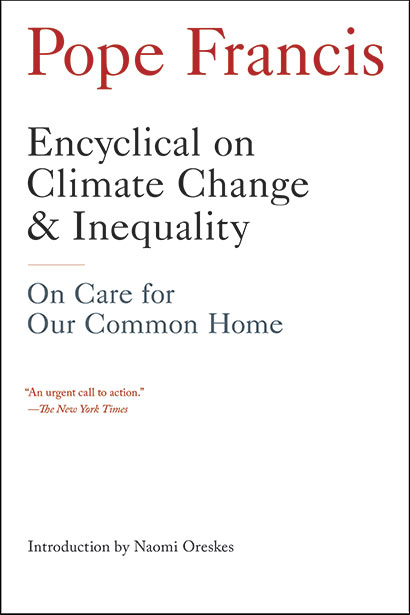
Encyclical on Climate Change & Inequality by Pope Francis. Melville House Publishing, $14.95.
Certainly the most important book we’ll read in a long time, this encyclical is worth buying in printed form if you absorb only the introduction by Naomi Oreskes, professor of the history of science at Harvard University. The book is Pope Francis 101, laying out the thinking of this amazing leader who clearly intends to be part of all our international conversations as long as he holds that powerful position. As Oreskes says, “While it has been billed as an encyclical on the environment, the letter covers virtually every important topic in contemporary life.”
In Pope Francis’s words, “Today, however, we have to realize that a true ecological approach always becomes a social approach; it must integrate questions of justice in debates on the environment, so as to hear both the cry of the earth and the cry of the poor.” We wish his writings were different on population control, but that’s too much to expect even for this bold man so early in his papal career. — Anita Johnson
![]() The Monopolists by Mary Pilon. Bloomsbury, $27.
The Monopolists by Mary Pilon. Bloomsbury, $27.
I had to read The Monopolists. I love board games, I love nonfiction that tells a tale and New York Times reporter Mary Pilon is a Eugene native. What seems like a simple game put out by Parker Brothers turns out to have started as a critique of capitalism created by a feminist and played by Quakers and was later twisted, thanks to personal and corporate greed, into the game it is today. History buffs and those interested in progressive politics, as well as anyone who likes a good game, will enjoy it. — Camilla Mortensen
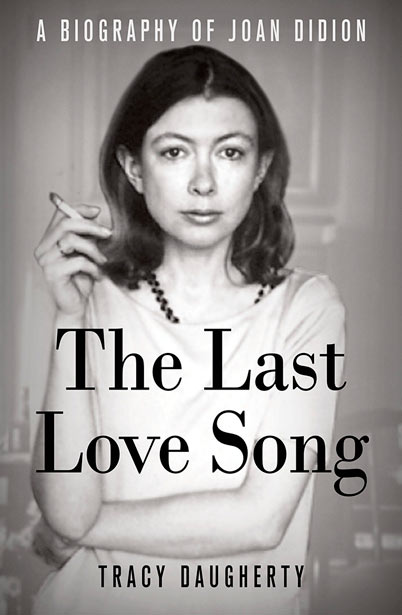
The Last Love Song by Tracy Daugherty. St. Martin’s Press, $35.
Critics have praised Tracy Daugherty’s exhaustive Joan Didion biography, The Last Love Song, for being a brave and astute examination of one of America’s most guarded writers. Certainly they’re right to. Daugherty dug deep, tracing the origins of Didion’s morbid fatalism back to her pioneer grandparents. He links her Spartan prose style to her early love of Hemingway and her time editing for Vogue magazine.
Considering Didion declined to be interviewed for the book, the level of detail Daugherty packs in is sometimes astounding. The trouble is, the story drags under the weight of so much minutiae. At close to 600 pages, Love Song’s chronological tour through Didion’s life often slams on the breaks in order to exhibit mundane anecdotes and pointless details. For example, we learn what entrée teenage Didion ordered on a dinner date. Daugherty devotes paragraphs to the time Didion’s superiors at Vogue gently chided her for wearing a hat to work. He even reports Didion’s menses and yeast infections.
Inapt moments like these break the spell, leading the reader to wonder if his approach is too encyclopedic to stand any real chance of cracking the Didion Code. Daugherty says he’s “fashioning literary biography as cultural history as well as an individual’s story.” Which sounds great, but what can a yeast infection reveal about an era or individual? — Ben Ricker

M Train by Patti Smith. Knopf, $25.
Patti Smith tells you right up front that her latest book M Train is about nothing. She’s lying. Instead, M Train is a beautiful meditation on aging, loss, grief, a life spent interacting with art and literature and — just a little — about what Smith does in her free time (chiefly drinking coffee in cafes, watching mystery shows and writing in her journal.)
In a stream-of-consciousness and experimental style, Smith comes across like the cool aunt you wish you had. M Train is very different than Smith’s bestselling memoir Just Kids, but no less compelling. The book is presented in the just-so fashion of a true bibliophile and print fetishist — get it in hardcover and skip the e-book, you won’t be disappointed. — Will Kennedy
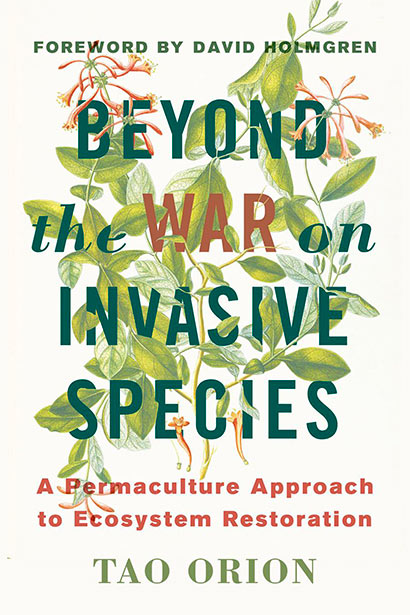
![]() Beyond the War on Invasive Species: A Permaculture Approach to Ecosystem Restoration by Tao Orion. Chelsea Green, $22.95.
Beyond the War on Invasive Species: A Permaculture Approach to Ecosystem Restoration by Tao Orion. Chelsea Green, $22.95.
Tao Orion asks a key question in her Beyond the War on Invasive Species: What if we look beyond the idea that invasive species are enemies and instead harnessed them for beneficial use? Rather than attack invasives with chemicals and bulldozers, why not look at their beneficial uses for medicine, food, compost and so on? Orion uses her background in permaculture and experiences in restoration work — as a botanist for Lane County’s public works and as an instructor at OSU and Aprovecho sustainable living education center — to inform a deep investigation into a more holistic approach to ecosystem restoration. She includes fascinating lists of organisms around the world, where they originated and where they wound up. — Camilla Mortensen
Dead Wake: The Last Crossing of the Lusitania by Erik Larson. Crown Books, $28.
I reached the halfway point of Erik Larson’s Dead Wake: The Last Crossing of the Lusitania the day after the Islamic State attacked Paris. It quickly became difficult to read accounts of civilians dying en masse, and I had to set the book aside for a couple of days.
I’m glad I finished Dead Wake. Larson’s true-life tale of the final voyage in 1915 of the British ocean liner Lusitania reminds us that targeting civilians in times of war is far from a novel practice, and was every bit as horrifying, every bit as incomprehensible then as it is now.
For those of us in the 21st century attempting to make sense of tragedy, this might be cold comfort, but perhaps the book can add some context in a larger sense.
As with Larson’s earlier works The Devil in the White City and In the Garden of Beasts, the divinity is in the details. Through meticulous historical research, Larson makes his reader feel like an intimate of members of Lusitania’s passenger manifest, of her crew and even of the German submariners that (spoiler alert) sink the ship as it nears Ireland.
The true wonder in Larson’s work lies in his considerable ability to leverage his undeniable writing chops against his own submarine dive through historical records, producing a prose style as crisp and immersive as an oncoming tide. He furnishes a historical footnote you last thought about in 10th-grade history class with nuance, with meaning.
The story’s frequent, fascinating digressions — from the practices of British naval code-breaking, to the odd confluence of spiritualism and architecture, to the unexpected amorous side of President Woodrow Wilson — flavor the narrative rather than thin it.
Larson so lovingly recreates the meals his real-life characters consumed, the clothing they wore, the flirtations they formed, the letters they penned and the history-changing event they shared, it’s a simple proposition for the reader to imagine Dead Wake the tale of an incident from a few scant weeks ago, not a century past. — Aaron Ragan-Fore
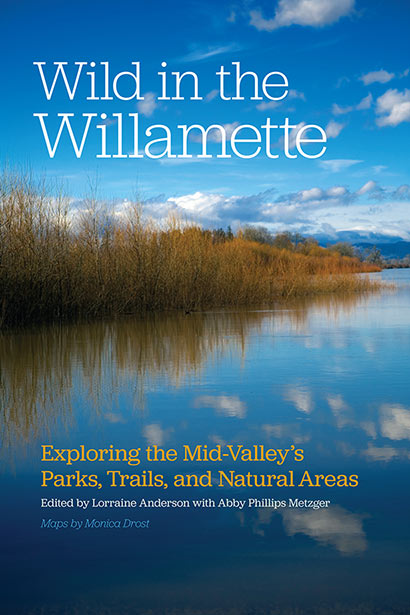
![]() Wild in the Willamette by Lorraine Anderson with Abby Phillips Metzger. OSU Press, $24.95.
Wild in the Willamette by Lorraine Anderson with Abby Phillips Metzger. OSU Press, $24.95.
I’m always looking for new places to explore, and in Oregon, there is no shortage of adventures to take, although sometimes it’s hard to select a path with so many choices. Wild in the Willamette helps narrow those choices as a detailed guide to the Willamette Valley, spanning the area’s natural landscapes with hiking descriptions, nature essays and repeated advocacy for preserving our precious resources in the heart of Oregon.
The book splits the Willamette Valley into seven distinct watersheds: Marys, Calapooia, South Santiam, North Santiam, Luckiamute, Yamhill and Pudding. The Willamette River flows as a central theme throughout the guide. Illustrations and maps sprinkle the pages, though there is no photography, save for the cover.
In the book’s pages, I was able to find one of my favorite hikes in the Willamette Valley, the stunning Silver Falls State Park near Salem, which boasts 10 successive waterfalls in an 8.7-mile loop. Many of the hikes, bikes or paddles mentioned in Wild in the Willamette are brand new to me — I’m excited to check out Ankeny National Wildlife Refuge, which is a “key stopover point for migratory shorebirds and other water birds such as American white pelicans and great egrets.”
You can never have too many travel guides, and this is one you don’t want to miss. — Amy Schneider
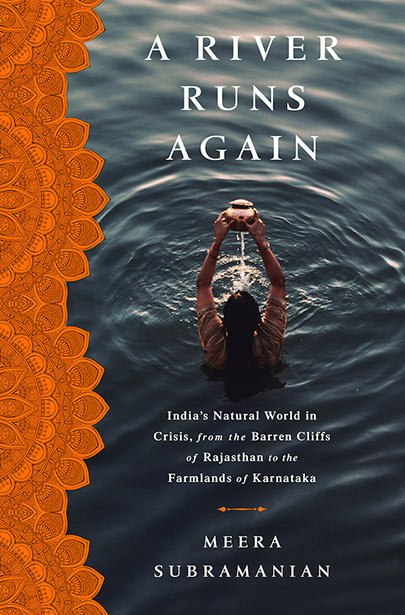
![]() A River Runs Again by Meera Subramanian. Perseus Books Group, $26.99.
A River Runs Again by Meera Subramanian. Perseus Books Group, $26.99.
Meera Subramanian’s book is a timely investigative piece on the development that ravages India’s environmental landscape, also focusing on the people working hard to repair the damages wrought by agriculture and industry. Subramanian, an investigative journalist who once worked at Aprovecho in Cottage Grove, writes with a deep passion for India, the country in which her father was born. She splits her story into five sections, each reflecting an element. The “air” section addresses India’s declining vulture population and the biologists devoted to reviving it, while the “water” section features dried-up wells in Rajasthan, where villagers work to bring water back to the land.
Subramanian’s story paints an often-grim portrait of India, as rampant use of chemicals in agriculture endangers the population and the environment. With tactfully used statistics and personal stories, A River Runs Again portrays India as a microcosm of the worldwide environmental crisis that our planet faces.
Each scene offers a glimpse into the people and places of India, and as Subramanian travels around the country, she draws the reader in with her lively descriptions and intimate looks into the lives of India’s residents. I was particularly impressed with the story of Pinki Kumari, a woman who teaches reproductive health in the poorer regions of India. The entire book is a sweeping story of loss and the fight for restoration — both maddening and hopeful, as many environmental stories are. — Amy Schneider

![]() Building a Better Nest by Evelyn Searle Hess. Oregon State University Press, $18.95.
Building a Better Nest by Evelyn Searle Hess. Oregon State University Press, $18.95.
Building a Better Nest is a perfect example of a book that cannot be judged by its cover. The photo on front and synopsis on back may imply this to be the story of a family who built an eco-friendly home or perhaps an instruction manual for those wishing to do so themselves. Instead, found amidst these pages is a theoretical discussion of the global issues facing future generations posed in the warm, pensive voice of Evelyn Hess.
Fighting elements both natural and society-made, Hess and her husband strive to accomplish a humble dream of creating a sustainable place to live on the property that houses their nursery in the coastal hills. Undeterred by torrential downpours, landslides and other mishaps, the couple is finally paused by the defeating prospect of funding such a project.
Framed by a seemingly small example, Hess relates her individual circumstance to the global conundrum that we all face: How do we combine the necessities of life with the ability to sustain life on this planet?
While the book’s conclusion is open-ended, it instills a sense of hope that with a little ingenuity and a lot of determination, we can rethink the way we reside in this beautiful world.
Recommended for the reader who desires to be challenged, frustrated and provoked to laugh and cry all from one tale. — Kory Bowlin
essays
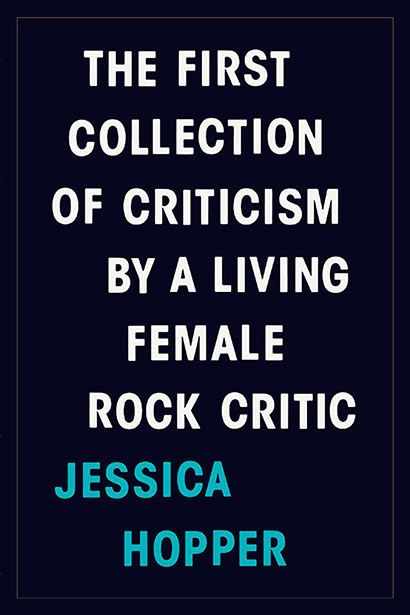
The First Collection of Criticism by a Living Female Rock Critic by Jessica Hopper. Featherproof Books, $18.
Ugly truths hide in the foreground, so I feel like an asshole for letting music critic Jessica Hopper ambush me with the revelation that “men writing songs about women is practically the definition of rock ‘n’ roll.” As a result, what classic rock radio can teach us about women is that they are mostly just doll-like objects of desire, lust, frustration and/or obsession. Buddy Holly pined like a simp over Peggy Sue. Chuck Berry asked why his Maybellene can’t be true. Just about the only Beatles song I can stand is the predatory “I’ll Get You,” whose menacing lyrics go: “It’s not like me to pretend / But I’ll get you, I’ll get you in the end / Yes I will, I’ll get you in the end / Oh yeah, oh yeah.” Until reading Hopper’s new book, The First Collection of Criticism by a Living Female Rock Critic, I hadn’t much considered the jacked-up power dynamics that come baked into our pop-music favorites or what effect they might have on young listeners — especially those who aren’t male. And the heretofore absence of that consideration seems to me suddenly very meaningful. Hopper predicts some readers will assume she’s a Grinchy spoilsport, but her essays attest over and over again to her pop music fandom. Hopper isn’t lobbying the reader to torch his/her Zeppelin records in solidarity “because who, other than a petty, too-serious bitch dismisses Zeppelin?!” The essays in Hopper’s book don’t revolve entirely around women’s limited access to rock. She writes deftly and cuts close to the heart of nearly every subject she picks up, whether it be the shameless Hungry Hungry Hippos-like money-grab that was the record executives’ response to Kurt Cobain’s suicide or a poignant interview with the reporter who broke the mostly forgotten story that R. Kelly is serial rapist. — Ben Ricker
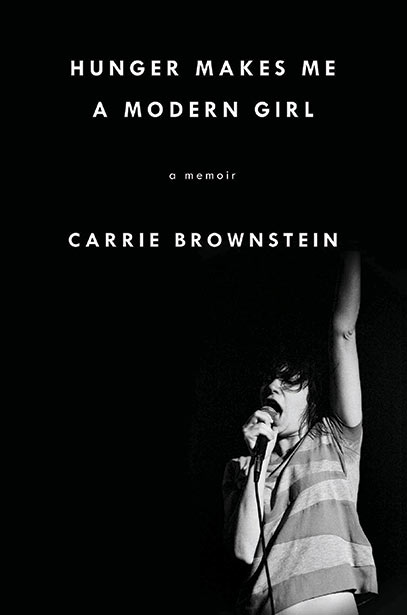
Hunger Makes Me A Modern Girl by Carrie Brownstein. Penguin Random House, $27.95
The Pacific Northwest of the ’90s is a magical, moody, insular land — at least, through the eyes of Carrie Brownstein in her new memoir Hunger Makes Me A Modern Girl. And what better shoulder to sit on to explore this music-drenched place in space and time than that of Sleater-Kinney’s guitarist and Portlandia’s star, once a little kid in Redmond obsessed with playing pretend.
“I was a puppy dog for punk,” Brownstein writes of her college days in Olympia, Washington — ground zero for the Riot Grrrl movement and any lo-fi, sludge-y alt bands looking for a place to give The Man the finger. It was in the basements of Olympia where Brownstein saw the likes of Elliot Smith, Rancid, Mary Lou Lord and Bikini Kill and on the stages of The Evergreen State College where she watched Nirvana and Mudhoney before they were names to know.
This artsy college town is where Brownstein met Corin Tucker, lead singer of pioneering Riot Grrrl band Heavens to Betsy. The two would go on to form Sleater-Kinney, who came out of hiatus in 2014 after eight years. Tucker brings Eugene into the book — she grew up here and attended South Eugene High School.
“Corin’s bravado was apt to court controversy,” Brownstein writes, “like the time in her hometown of Eugene, Oregon, when she yelled at a sound guy on my behalf that I couldn’t hear my vocals and he got so fed up that he shut off the PA.”
The book is a great read for music lovers, but it’s more than that. Brownstein lays bare her lifelong struggle with anxiety and depression, issues that fame and success can’t erase, and which touring with a band has exacerbated. And yet, the beauty, magic and inspiration come from the way Brownstein has managed the hand she was dealt, while creating great art in the process. — Alex V. Cipolle
Between the World and Me by Ta-Nehisi Coates. Penguin Random House, $27.95
In the violent, polarized country we live in today, Ta-Nehisi Coate’s Between the World and Me should be required reading for every man, woman and child. Coates, a preeminent writer and journalist (The Atlantic, The Village Voice, Time), has written a tender, heartbreaking and rousing work, framing it as a letter to his son, a 15-year-old black teen living in America — or to put it bluntly, a walking target for the aggression and the insidious (and not-so-insidious) racism that plagues the U.S. today.
Coates writes: “But this banality of violence can never excuse America, because America makes no claim to the banal. America believes itself exceptional, the greatest and noblest nation ever to exist, a long champion standing between the white city of democracy and the terrorists, despots, barbarians, and other enemies of civilization.”
Read it, tell your neighbors to read it and start talking about how we can dig ourselves out of the mess we’ve made. — Alex V. Cipolle
kids, teens & tweens
![]() Jackaby and Beastly Bones by William Ritter. Algonquin Young Readers, $17.95.
Jackaby and Beastly Bones by William Ritter. Algonquin Young Readers, $17.95.
It’s 1892 and Abigail Rook is looking for a job in New Fiddleham, New England. No sooner has she gotten off the ship she took from Europe than she meets the peculiar detective R.F. Jackaby. He uses Sherlockian deduction mixed with some Harry Potteresque cryptozoological beings to determine Abigail has recently been in Eastern Europe. Not that long after their chance encounter, the intrepid Abigail enters into his employ and meets the supernatural residents of his home.
Billed as Doctor Who meets Sherlock Holmes, the young adult novel Jackaby and its sequel Beastly Bones will appeal to the YA readers who are Harry Potter and mystery lovers, and judging from a plethora of videos and YouTube reviews (which are apparently a thing), the novels have gotten a loyal following.
Local readers will notice that there is a certain Lane County flair to the books, despite their New England setting. Author William Ritter lives in Springfield, and one of the characters — a homeless woman with a hint of supernatural powers, Hatun — bears a strong resemblance to Hatoon, aka Victoria Adkins, an unhoused woman who made her home near the University of Oregon bookstore, where a shrine to her remains. Adkins was hit by a car and died in 2005, and she was mourned by the many who knew her around campus.
“Jackaby hesitated,” Ritter writes, “and when he spoke, his answer had a soft earnestness to it. ‘Hatun sees a different world than you or I, a far more frightening one, full of far more terrible dangers, and still she chooses to be the hero whom that world needs. She has saved this town and its people from countless monsters countless times. That the battles are usually in her head does not lessen the bravery of it. The hardest battles always are.’” — Camilla Mortensen
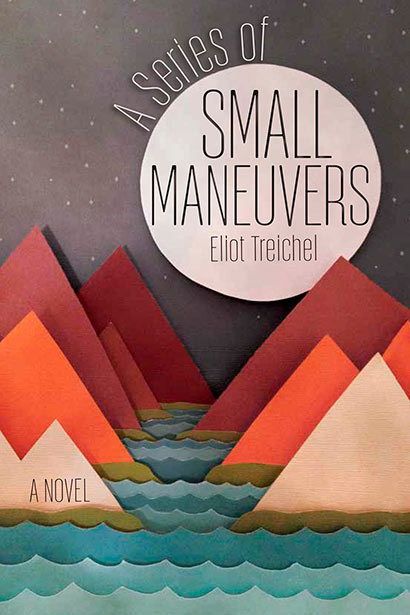
![]() A Series of Small Maneuvers by Eliot Treichel. Ooligan Press, $14.95.
A Series of Small Maneuvers by Eliot Treichel. Ooligan Press, $14.95.
“Sometimes things never make sense, but making sense is also sometimes never the point.” Such is Emma’s mother’s reply when Emma inquires whether her younger sister understands the death of their father. His death and Emma’s struggle to integrate it into her life and deal with her sense of guilt and loss spell the heart of this young adult novel. Many such poignant morsels of wisdom are littered throughout its pages.
This is not a sensational indulgence in the tragedy of death or an emotionally overwrought rollercoaster through exploding scenery. Emma’s father does die while they are on a canoeing trip intended to bring them closer together and she feels a heavy responsibility for the accident, but that moment doesn’t consume the rest of the story by acting as a cheap, charged motif to circle back to in an attempt to keep the drama alive.
Well crafted and stylistically unornamented, Treichel pierces straight to the heart of his tale. It reads like an expanded short story, given his passion for detail, but he is not frivolous or self-indulgent with it. His style is quiet and unassuming, drawing you into it without you realizing how intense and barefaced his story will be. — Paul Quillen
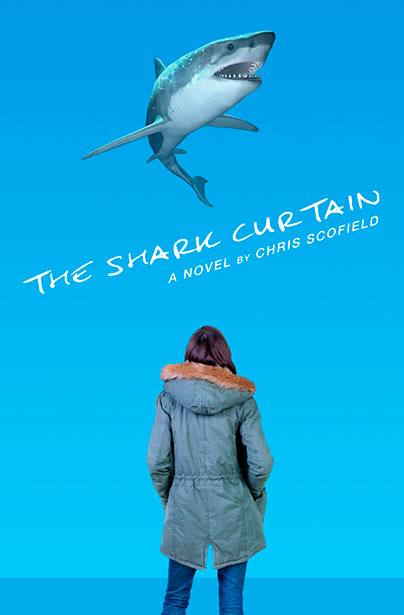
![]() The Shark Curtain by Chris Scofield. Black Sheep/Akashic Books, $13.95.
The Shark Curtain by Chris Scofield. Black Sheep/Akashic Books, $13.95.
Chris Scofield’s debut novel The Shark Curtain takes readers deep into Lily Asher’s 1960s Portland, where her family and those around her are just as puzzled by her naiveté and artistic nature as she is by their philandering and problems with alcohol and gambling. Ever the outsider, Lily’s conversations with Jesus (or, as she calls him, SOG) and her tendency to bark in public after the death of her dog, Mrs. Wiggins, show Lily’s disconnection with the surrounding world as she struggles through her teenage years. Is Lily autistic? Misunderstood? In her ’60s-era youth, she’s simply a weirdo, and a weirdo that all of us with a lot of imagination and all-too-frequent internal conversations can relate to. The Shark Curtain is worth a read by teens and adults alike. — Camilla Mortensen
Goodbye Stranger by Rebecca Stead. Wendy Lamb Books, $16.99.
Newberry Award winner Rebecca Stead comes back with another gem in Goodbye Stranger, in which she interweaves the perspectives of three best friends entering their teen years, a young boy at their school and an unnamed high school girl. The book’s central character, 13-year-old Bridge, is trying to figure out friendship, growing up, falling for someone and why she’s still alive after an accident five or so years before almost killed her. Stead writes with a sympathetic understanding of the troubles, big and small, that can overwhelm a middle school girl. — Camilla Mortensen
